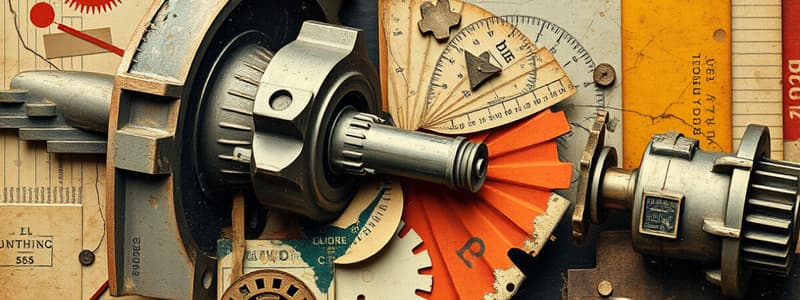Podcast
Questions and Answers
What is the difference between ferrous and nonferrous metals?
What is the difference between ferrous and nonferrous metals?
- Nonferrous metals contain iron.
- Nonferrous metals are composed primarily of iron.
- Ferrous metals do not contain iron.
- Ferrous metals are composed primarily of iron. (correct)
What is an alloy?
What is an alloy?
A metal with other elements intentionally added to create different characteristics.
Name three alloying elements added to steel.
Name three alloying elements added to steel.
Carbon, Chromium, Nickel.
Define cast iron.
Define cast iron.
What element makes stainless steel corrosion resistant?
What element makes stainless steel corrosion resistant?
What small particles of alloys are flammable?
What small particles of alloys are flammable?
What are two major benefits of titanium?
What are two major benefits of titanium?
What does AISI stand for?
What does AISI stand for?
What does SAE stand for?
What does SAE stand for?
What are the major alloying elements in 8730 steel?
What are the major alloying elements in 8730 steel?
What is the carbon content of 8730 steel?
What is the carbon content of 8730 steel?
What does IADS stand for?
What does IADS stand for?
What is the overall purity of 1030 Aluminum?
What is the overall purity of 1030 Aluminum?
What are the major alloying elements of 6061 Aluminum?
What are the major alloying elements of 6061 Aluminum?
What does UNS stand for?
What does UNS stand for?
What is an alloy steel?
What is an alloy steel?
What is an aluminum alloy?
What is an aluminum alloy?
What is brass?
What is brass?
What is bronze?
What is bronze?
What is cast iron?
What is cast iron?
What is a copper alloy?
What is a copper alloy?
What are superalloys?
What are superalloys?
Give examples of nonferrous metals.
Give examples of nonferrous metals.
What is the UNS prefix for cast iron?
What is the UNS prefix for cast iron?
What is the UNS prefix for titanium?
What is the UNS prefix for titanium?
What is the UNS prefix for copper alloys?
What is the UNS prefix for copper alloys?
Give an example of what aluminum is used for.
Give an example of what aluminum is used for.
Give an example of what cast iron is used for.
Give an example of what cast iron is used for.
Give an example of what tool steel is used for.
Give an example of what tool steel is used for.
Give an example of what cold rolled steel is used for.
Give an example of what cold rolled steel is used for.
Give an example of what martensitic stainless steels are used for.
Give an example of what martensitic stainless steels are used for.
Give an example of what austenitic stainless steels are used for.
Give an example of what austenitic stainless steels are used for.
What is austenitic?
What is austenitic?
What are the types of cast iron?
What are the types of cast iron?
What are the types of stainless steel?
What are the types of stainless steel?
Flashcards are hidden until you start studying
Study Notes
Metal Composition and Classification
- Ferrous Metals: Composed primarily of iron; nonferrous metals lack iron.
- Alloy Definition: A metal mixed with other elements to achieve various characteristics.
Alloying Elements
- Common Alloying Elements in Steel: Carbon, Chromium, Nickel.
- 8730 Steel Alloying Elements: Manganese, Chromium, Nickel, Molybdenum.
- Major Alloying Elements in 6061 Aluminum: Magnesium and Silicon.
Material Properties
- Cast Iron: Hard and brittle metal with high carbon content; used in car suspension parts.
- Stainless Steel Corrosion Resistance: Achieved by adding Chromium.
- Titanium Benefits: Low density and high strength; used in aerospace components, motorsports, and surgical implants.
- Sulfur Alloys: Example of superalloys includes nickel-based metals with the UNS prefix S, N, or R.
Metal Identification Systems
- AISI (American Iron and Steel Institute): Organization providing standards for metals.
- SAE (Society of Automotive Engineers): Focuses on automotive standards.
- IADS (International Alloy Designation System): An older alloy classification system.
- UNS (Unified Number System): A system for identifying metals with specific prefixes.
Carbon and Purity Content
- 8730 Steel Carbon Content: Ranges from 0.25% to 0.35%.
- Purity of 1030 Aluminum: 99.3%.
Alloy Types
- Alloy Steel: Steel enhanced by various added elements.
- Aluminum Alloy: Contains aluminum as the majority metal.
- Brass: Alloy of copper and zinc.
- Bronze: Alloy of copper and tin, sometimes with other metals.
- Copper Alloy: Mixture of copper as the principal metal with others.
- Types of Cast Iron: Includes gray iron, malleable iron, and ductile iron.
- Stainless Steel Types: Austenitic, ferritic, martensitic; contains at least 10% chromium.
Metal Applications
- Aluminum: Best suited for applications like handrails.
- Tool Steel: Utilized for punches, dies, etc.
- Cold Rolled Steel: Commonly used in aircraft braces.
- Martensitic Stainless Steels: Ideal for knife blades.
- Austenitic Stainless Steels: Recommended for conveyor parts.
UNS Prefixes
- Cast Iron Prefix: F
- Titanium Prefix: R
- Copper Alloys Prefix: C
Nonferrous Metals
- Examples: Copper, magnesium, and titanium; not containing iron.
Studying That Suits You
Use AI to generate personalized quizzes and flashcards to suit your learning preferences.




